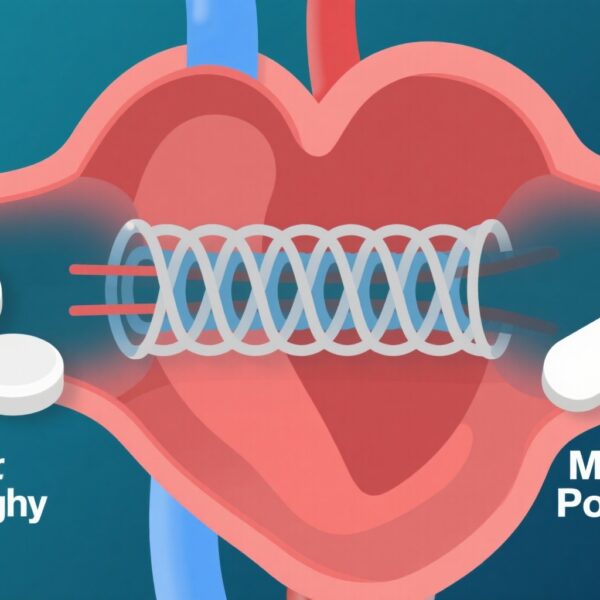Introduction
Percutaneous coronary intervention (PCI) remains a cornerstone therapy for coronary artery disease, especially in patients with acute coronary syndrome (ACS) or stable coronary disease but often carries risks of bleeding and ischemic complications. Dual antiplatelet therapy (DAPT), combining aspirin and a P2Y12 inhibitor, is standard after PCI to reduce ischemic events but increases bleeding risk. Patients with high bleeding risk (HBR) pose a unique therapeutic challenge, as bleeding and ischemic complications can both lead to adverse outcomes. An aspirin-free strategy—prasugrel monotherapy instead of DAPT—has been proposed to reduce bleeding without compromising ischemic protection. However, its efficacy and safety, particularly stratified by ACS status in HBR patients, have not been fully elucidated.
Study Background and Disease Burden
Patients with HBR undergoing PCI are vulnerable to major bleeding events, which adversely affect prognosis and complicate antithrombotic management. ACS patients inherently carry higher ischemic risk due to plaque disruption and thrombus formation, leading to myocardial infarction (MI), stent thrombosis, or stroke. Balancing bleeding and thrombotic risks is crucial in this population to optimize outcomes. The STOPDAPT-3 trial, a randomized clinical trial, investigated whether aspirin-free therapy with prasugrel monotherapy could reduce bleeding compared to standard DAPT in patients with or without ACS and high bleeding risk after PCI. This subgroup analysis aimed to investigate differences in outcomes by ACS status.
Study Design
This subgroup analysis included 3258 patients classified as high bleeding risk in the STOPDAPT-3 trial. Participants were stratified by ACS status: 1803 had ACS and 1455 had non-ACS indications for PCI. Patients were randomized to either no-aspirin treatment (prasugrel monotherapy) or standard DAPT (aspirin plus prasugrel). The primary safety endpoint was major bleeding assessed at 1 month post-PCI. The primary efficacy endpoint was a composite of cardiovascular death, myocardial infarction, definite stent thrombosis, or ischemic stroke. Hazard ratios (HRs) with 95% confidence intervals (CIs) were calculated, and subgroup interactions assessed.
Key Findings
The aspirin-free strategy did not significantly reduce the incidence of major bleeding compared with DAPT in patients with HBR regardless of ACS status. In ACS patients, major bleeding rates were 7.3% with no-aspirin versus 7.9% with DAPT (HR 0.91, 95% CI 0.65–1.28), and in non-ACS patients 3.1% versus 2.9% (HR 1.06, 95% CI 0.58–1.93), with no significant interaction (P=0.66).
In terms of ischemic events, a numerically higher risk was observed in patients with ACS treated with no-aspirin compared to DAPT for the composite of cardiovascular death, MI, stent thrombosis, or stroke (7.9% vs. 5.8%; HR 1.39, 95% CI 0.97–1.99). Conversely, non-ACS patients showed a similar or slightly lower risk with no-aspirin (2.4% vs. 3.0%; HR 0.78, 95% CI 0.41–1.47). Interaction testing did not reach statistical significance (P=0.12).
Strikingly, myocardial infarction rates showed significant treatment-by-subgroup interaction (P=0.02). In ACS patients, MI incidence was notably higher with no-aspirin (1.6%) than with DAPT (0.3%) (HR 4.57, 95% CI 1.31–15.89), whereas in non-ACS patients, MI was slightly less frequent with no-aspirin (1.4%) vs DAPT (1.8%) (HR 0.78, 95% CI 0.34–1.77).
These results highlight a safety signal concerning ischemic risk, particularly MI, in ACS patients treated without aspirin after PCI despite high bleeding risk.
Expert Commentary
This subgroup analysis provides pivotal insights into the aspirin-free antiplatelet approach in the delicate balance of ischemic and bleeding risks among high-risk PCI patients. The failure of prasugrel monotherapy to reduce major bleeding suggests aspirin omission alone might be insufficient to mitigate bleeding risk, possibly due to prasugrel’s potent platelet inhibition. The pronounced increase in MI risk in ACS patients without aspirin supports the notion that aspirin remains essential in the early post-PCI period for this subgroup, likely due to heightened platelet activation and thrombotic potential inherent in ACS.
Conversely, the aspirin-free strategy appeared safe in non-ACS HBR patients, consistent with the relatively lower thrombotic burden and potentially stable plaque morphology in this group. This finding aligns with accumulating evidence favoring shortened or less intensive antiplatelet regimens in stable coronary disease to reduce bleeding without compromising ischemic protection.
The study’s randomized design and robust sample size strengthen its conclusions; however, 1-month follow-up limits assessment of longer-term outcomes. Also, the choice of prasugrel monotherapy, a potent P2Y12 inhibitor, may have specific pharmacodynamic effects not generalizable to other agents. Further research is warranted to clarify optimal antiplatelet regimens for diverse HBR subpopulations.
Conclusion
In patients with high bleeding risk undergoing PCI, an aspirin-free strategy using prasugrel monotherapy did not reduce major bleeding events compared to standard dual antiplatelet therapy, regardless of ACS status. Importantly, among ACS patients, the aspirin-free strategy was associated with a significantly increased risk of myocardial infarction, highlighting aspirin’s crucial role in this high-thrombosis-risk group. In contrast, aspirin omission may be a viable strategy in non-ACS patients to balance bleeding and ischemic risk.
Clinicians should carefully consider ACS status when tailoring antiplatelet therapy in HBR patients after PCI. The aspirin-free regimen may represent an important treatment option in selected non-ACS patients but is not currently recommended in ACS patients due to increased ischemic risk. Ongoing trials and mechanistic studies will further refine individualized antiplatelet strategies to optimize outcomes.
References
Ishikawa T, Natsuaki M, Watanabe H, Morimoto T, Yamamoto K, Obayashi Y, Nishikawa R, Ando K, Suwa S, Isawa T, Takenaka H, Yoshida R, Suzuki H, Nakazawa G, Kusuyama T, Morishima I, Hojo S, Tsutsumi J, Yamamoto H, Ueda H, Ono K, Kimura T. Aspirin-Free Strategy for PCI in Patients With High Bleeding Risk With or Without Acute Coronary Syndrome: A Subgroup Analysis From the STOPDAPT-3 Trial. Circ Cardiovasc Interv. 2025 Jul;18(7):e015197. doi: 10.1161/CIRCINTERVENTIONS.124.015197. Epub 2025 May 14. PMID: 40365675.
Valgimigli M, Bueno H, Byrne RA, et al. 2017 ESC focused update on dual antiplatelet therapy in coronary artery disease: An ESC guideline update. Eur Heart J. 2018 Jan 7;39(3):213-260. doi: 10.1093/eurheartj/ehx419.
Urban P, Mehran R, Colleran R, et al. Defining high bleeding risk in patients undergoing percutaneous coronary intervention: a consensus document from the Academic Research Consortium for High Bleeding Risk. Eur Heart J. 2019 Oct 14;40(10):2632-2653. doi: 10.1093/eurheartj/ehz372.
Knuuti J, Wijns W, Saraste A, et al. 2019 ESC Guidelines for the diagnosis and management of chronic coronary syndromes. Eur Heart J. 2020 Aug 14;41(3):407-477. doi: 10.1093/eurheartj/ehz425.


